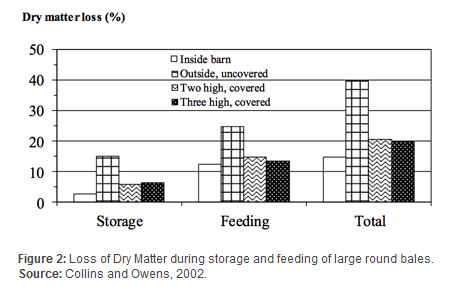6 Ways to Minimize Shrink Loss in Forage Storage Methods

By Karla Hernandez, South Dakota State University
Producers need to find ways to prevent shrink losses in their bunkers and storage systems. Stored forages provide the essential nutrients for livestock when pastures are inadequate and are consistent feed supplies for dairies, sheep flocks, cow/calf producers, and beef feedlots. However, some of these nutrients can be lost if forages are not stored properly. Common forms of preservation are hay (forage preserved by field drying to moisture levels; below 20%) and silage (forage preserved at low pH by partial anaerobic fermentation of sugars). Preservation as silage usually tends to minimize dry matter (DM) losses during harvest (Figure 1 and Figure 2). Interestingly, a large part of the lost in DM in silage systems is lost during the storage phase, whereas, losses for hay generally occur during harvest.
Hay storage losses are around 5% for hay harvested at 15% moisture and stored under dry conditions. Forage quality tends to decrease if hay is baled above 20% moisture (Collins and Owens, 2002). However, hay storage loss could be avoided if we prevent microbial growth and heating. Moreover, poor storage conditions will result in higher losses in DM.
Types of Storage Losses
Stored forage can be subject to DM and forage quality losses. Losses of dry hay stored inside a barn are usually not a concern, however, even for barn stored hay; losses tend to increase when hay moisture is above 20% (Figure 2). Each mechanism in forage-preservation process (i.e., mowing, ranking, chopping, baling, storing, and unloading) will probably cause loss of a forage dry matter. Some losses are either mechanical or biological. For hay-making, most of the losses come from mechanical or weather damage, whereas, for silage-making, most losses will occur at storage and feed out stages. In general, round bales are usually subject to greater losses than small rectangular bales, because they tend to remain outside with no protection between baling and feeding. Other aspects to take in consideration when determining the storage quality of the forage are: (1) the presence of respiration (aerobic conditions) and microbial activity, (2) maillard reactions (nonenzymatic browning), (3) inside storage, (4) outside storage, and (5) stack arrangement (Figure 2).
Minimizing Losses
This aspect can be summarized by using good management practices. A summary of good hay making practices will be shown below (Table 1).
| Table 1 |
 |
As such for a good silage management, we should take in consideration the following aspects:
- Harvest at correct maturity and moisture concentration.
- Fill the bunker as rapidly as possible.
- Pack well and seal the bunker to reduce oxygen infiltration for at least 14 days to allow the fermentation process.
- Feed appropriate rate to reduce face exposure to oxygen.
- Unload an average of 2-6 inches/day to keep the surface smooth. This will limit aerobic deterioration and will help to reduce any possible spoilage.
- Discard deteriorated silage, which will help preventing livestock health problems.
 |
 |







